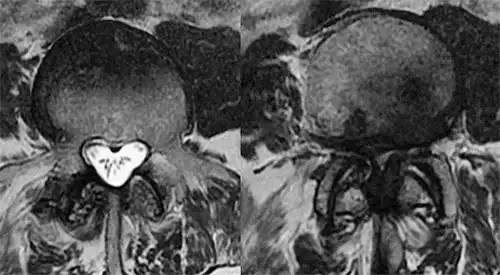Canal Stenosis
"A channel a little narrower than usual does not have to cause discomfort in a person. However, when the space continues to diminish and compress the internal structures, is when it begins to be symptomatic".
DR. MATÍAS ALFONSO
SPECIALIST. ORTHOPEDIC SURGERY AND TRAUMATOLOGY DEPARTMENT

Spinal canal stenosis is a narrowing of the space through which the spinal cord and nerve roots pass. It covers from the occipito-cervical zone to the lombo-sacral zone.
The origin of the stenosis can be of many types (traumatic, neoplastic, etc.) although the great majority is usually degenerative.
It is produced by a degeneration of the adjacent tissue, like a ligamentary hypertrophy or of the vertebral facet joints that produce growth of the same ones and occupation of part of the spinal channel, compressing the nervous elements and causing the symptomatology
It is a relatively common disorder in patients over 50 years, although sometimes occur in younger patients by presenting a congenital narrow spinal canal. Also it is habitual that they coexist with herniated discs or deformities in the spine.

What are the symptoms of spinal stenosis?
A spinal canal that is a little narrower than usual does not have to cause discomfort to a person. However, when the space continues to shrink and compress the internal structures, this is when it begins to be symptomatic.
Depending on the affected vertebral level, it can cause a certain clinic.
Estenosis at lumbar or dorsal level:
- The neurogenic claudication of the march consists of a pain, annoyances or heaviness in one or both legs at the time of being walking, which forces the patient to have to sit down and to rest. Within minutes of sitting down, the patient can typically recover and continue walking.
- Tingling and weakness in the legs
Stenosis at the cervical level:
- Difficulty walking, instability, spasticity etc.
- Pain in the arms and hands. Sometimes also in legs.
- It can also give local lumbar, cervical or dorsal pain due to muscular contractures.
The symptomatology usually appears progressively during months or even years. Although it can appear with a triggering event such as trauma.
The maneuvers of waltz (to cough, to sneeze, to increase the pressure in abdomen when going to the bathroom) can increase the symptomatology.
The most common symptoms are:
- Pain, discomfort or heaviness while walking.
- Tingling and weakness in the legs.
- Difficulty walking, instability, spasticity.
- Pain in arms, hands and/or legs.
Do you have any of these symptoms?
You may have a stenosis of the spinal canal
How is spinal stenosis diagnosed?

The diagnosis is made, in addition to the symptoms referred by the patient, by performing an X-ray and in most cases is complemented by the performance of a magnetic resonance imaging (MRI) or a scanner (CT).
How is spinal canal stenosis treated?
There are a variety of treatments for this condition, although pharmacological and rehabilitative treatment is usually the initial one.
If the conservative treatment is not sufficiently effective, surgery is of choice through subsequent decompression (hemi or laminectomy and flavectomy), with the possibility of adding stabilization if necessary.
The most frequent operation is simple selective decompression, in which more space will be made in the canal, removing the ligaments and part of the bone that is causing the compression, by posterior route. It is usually an operation with positive results and patients refer improvement when walking.
Osteosynthesis (usually titanium screws and rods) is used if there is previous instability, or if it is known that it will become unstable during the surgical procedure.
Intersomatic devices (TLIF, XLIF, ALIF etc.) can be used to increase system stability and improve spinal fusion rates.
Where do we treat it?
IN NAVARRE AND MADRID



